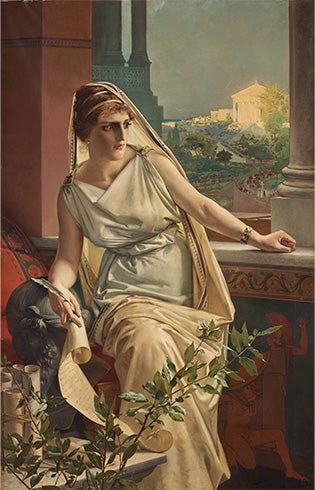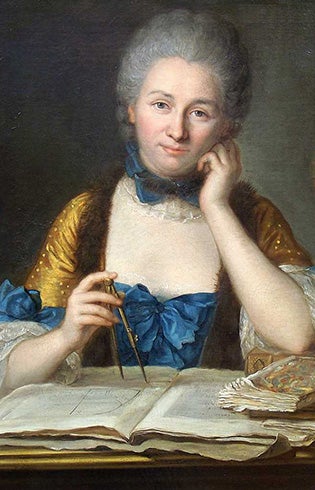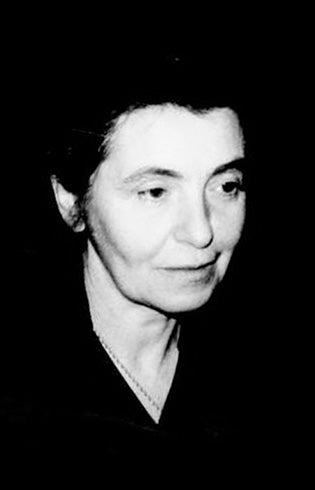
Female mathematicians throughout history overcome barriers to excel in a male-dominated field
For centuries, men have been the dominant figures in mathematics. Women, however, have been making important contributions since ancient times.

Among the earliest well-documented female mathematicians is Hypatia, a Greek Neoplatonist philosopher who lived in Alexandria from about 360 to 415 C.E. Some historians credit her with inventing the hydrometer, an instrument used to measure the density of liquids. She also is known to have constructed astrolabes, which astronomers used to study celestial bodies.
“I just love her passion and envision her looking at the stars and their elliptical orbits and wondering why the orbits have that shape,” said Cymra Haskell, professor of mathematics at the USC Dornsife College of Letters, Arts and Sciences and an admirer of her ancient predecessor.
Hypatia’s work broke ground for Haskell and other women mathematicians in the generations that followed, including Maryam Mirzakhani, who in 2014 became the first woman to win the Fields Medal, the most prestigious prize for mathematicians under 40.
The stories of Hypatia and Mirzakhani are among many highlighting the long, historic struggle of women to gain a foothold in the world of mathematics.
After a pause, women reemerge as significant figures in math

For more than a millennium after Hypatia, progress in women’s contributions to mathematics stalled until the emergence of two standout women.
Elena Lucrezia Cornaro Piscopia helped reignite the momentum of women in the field in 1678, when she became the first woman to earn a PhD. Though her doctorate was in philosophy, Piscopia became a mathematics lecturer at the University of Padua that same year and later a member of various academies throughout Europe.
Born four decades later, Maria Agnesi would be remembered as the first woman to write a mathematics textbook. Assistant Professor (Teaching) of Mathematics Nathaniel Emerson, who teaches USC Dornsife’s “History of Mathematics” (MATH 450) course, says, “Her greatest contribution was that she brought calculus to a wider audience which helped in the education of mathematics students for generations.”
Agnesi wrote The Analytical Institutions in 1748, one of the first books to cover the subject of finite and infinitesimal analysis — better known as calculus. Soon after, she was elected to the Bologna Academy of Sciences.
She is also known for her work on the “Witch of Agnesi,” a good example of combining two 17th-century mathematical topics, analytic geometry and calculus.
Around the time Agnesi was making headway in Italy, France produced a remarkable female mathematician, one who caught the attention of USC Dornsife Professor of Mathematics Susan Friedlander some 30 years ago when Friedlander encountered a portrait in the Château de Breteuil outside Paris.
Friedlander later wrote about the mathematician, Emilie de Breteuil, Marquise du Châtelet, for the Bulletin of the American Mathematical Society, of which Friedlander is editor-in-chief.
Friedlander noted that while Du Châtelet “is famous for being the lover, companion, and scientific collaborator of Voltaire,” the importance of her work in mathematics, physics and natural philosophy has gained more recognition in recent times.
In 1738, Du Châtelet became the first woman to have a paper published by the French Academy of Sciences, and her translation of Isaac Newton’s momentous Philosophiae Naturalis Principia Mathematica (Mathematical Principles of Natural Philosophy) into French has been widely lauded.
Women earned math PhDs despite being barred from courses

Russian-born Sofia Kovalevskaya continued making headway for women in mathematics in the late 1800s. She received a PhD in 1874 from Göttingen University in Germany, even though she was not officially enrolled due to her gender.
“The circumstances were exceptional; she had to ask each professor for special permission to take his class,” Emerson said. He points out that Piscopia faced the same restriction; she was never enrolled in a university either. Women wouldn’t be allowed to enroll until the 1880s, according to Emerson.
Kovalevkaya’s noteworthy contributions to analysis, partial differential equations, and mechanics culminated in her becoming the first woman to be awarded the Prix Bordin (Bordin Prize) by the French Academy of Sciences in 1888. She went on to lecture in Stockholm, earn a prize from the Swedish Academy of Sciences, secure a university chair in Europe, be elected to the Russian Academy of Sciences, and publish 10 papers before succumbing to influenza in 1891.
Like many women before her, Russian Olga Ladyzhenskaya was denied entry as an undergraduate at university — but not because she was a woman. This time, politics and her ties to nobility impeded her advancement.
By 1939, the Stalinists had taken control of Russia, deeming nobles and intellectuals enemies of the state. Ladyzhenskaya’s father was arrested and executed without trial. Ironically, because of her research in partial differential equations and fluid dynamics, Ladyzhenskaya was granted additional provisions from the state and excused from compulsory lectures so she could attend mathematical seminars.
Ladyzhenskaya is credited with one of the most important advancements in the field of mathematics of the 20th century, a crucial breakthrough in the Navier-Stokes equations, which describe how the relationship between the velocity, pressure, temperature and density of a moving fluid. She was awarded the Lomonosov Gold Medal in 2002 and authored more than 200 scientific publications.
Mathematicians continue efforts toward equity in their field
Inequity in representation and compensation remain key issues in the field, and solving either should help improve the other, according to USC Dornsife Professor of Mathematics and Associate Director of Graduate Studies Sami Assaf.
“Women in mathematics continue to be underrepresented and underpaid compared to men. Changing either of these will no doubt impact the other,” she said.
According to the National Center for Science and Engineering Statistics, just over 40% of bachelor’s and master’s degrees in mathematics were earned by women. That statistic drops to under 30% at the doctoral level.
Aiming to address this shortcoming, Hypatia enthusiast Haskell founded Charlotte’s Web, a math club that aims to build a community for women pursuing graduate degrees in mathematics at USC Dornsife, in 2000. Haskell’s observations of the dynamics between male and female mathematicians revealed to her the tendency for individuals to internalize imposter syndrome and feel like they don’t belong. She believes clubs like Charlotte’s Web can help address this issue.
Emerson notes that women also face challenges when teaching math that men do not, such as receiving uninvited comments on their appearance and encountering resistance to their authority as instructors. This, and the fact that many girls veer away from math in middle school, reduces their representation in the field. He hopes women will feel that they have a choice to pursue a career in mathematics.
“I have a feeling the reason girls often check out of math in middle school has to do with the overwhelming number of male teachers,” he said. “I definitely had students at USC tell me they’ve never had a female math teacher.”
Fields Medalist Mirzakhani bucked the trend of girls losing interest in math after middle school. Her passion for the subject didn’t start until high school, but her success came quickly after.
Growing up in Iran, she attended an all-girls school for exceptionally talented students, and in 1994, at 17 years old, she made the Iranian Math Olympiad team and won a gold medal. She went on to earn her PhD at Harvard in 2004, become a research fellow at the Clay Mathematics Institute and a professor at Princeton University. In 2009, she joined the faculty at Stanford University.
Her Fields Medal, awarded for her work on Riemann surfaces and moduli spaces, marked a breakthrough for women in mathematics and built on Hypatia’s legacy, established 1,600 years earlier.
Mirzakhani died in 2017 after a battle with cancer, but not before establishing her own legacy for mathematicians — and especially women in mathematics — to further build upon.